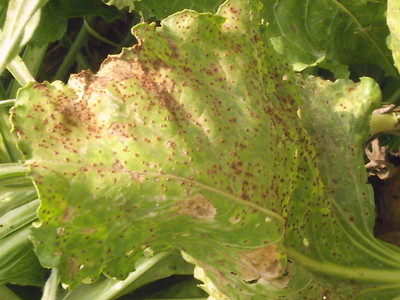Inducing Resistance Against Rust Disease of Sugar Beet by Certain Chemical Compounds
A. A. Ata 1 ; M. G. El-Samman 2 ; Maysa, A. Moursy 1 and M. H. Mostafa 2
1. Maize and Sugar Crops Diseases Section, Plant Path. Res. Inst., A. R. C., 9 Gama st ., Giza, Egypt .
2. Plant Path. Dept., Fac. Agric., Ain Shams Univ., Shoubra El-Kheima, Cairo, Egypt .
Five chemical compounds in three concentrations, i.e. hydrogen peroxide (H2O2, 0.25, 0.50 and 1.0 %), salicylic acid (SA), mono and di-basic potassium phosphate (KH2PO4 and K2HPO4) and Bion (BTH) at (2, 4 and 8 mM) were applied as foliar spray to evaluate their capabilities to induce resistance against rust disease of sugar beet caused by Uromyces betae Tul. ex Kick in greenhouse and field trials during 2006/ 07 growing season in Damietta and Kafr El-Sheikh governorates.
In greenhouse under artificial inoculation and under natural infection in field experiments during 2006/ 07 growing season, all tested chemicals significantly reduced both disease incidence and severity. Hydrogen peroxide at 1.0 % and 0.5 %, salicylic acid and di-basic potassium phosphate at 8 mM were the most effective treatments, while Bion was the least effective one. Score fungicide, showed the highest effect against rust disease occurrence. Moreover, hydrogen peroxide at 1.0 %, salicylic acid and di-basic potassium phosphate at 8 mM significantly increased root weight/ plant, sucrose % and reduced non-sucrose chemical compounds resulting in high juice quality percentage.
Spraying sugar beet plants with all tested chemicals individually increased activity of both peroxidase (PO) and polyphenoloxidase (PPO) in sugar beet leaves compared with untreated infected leaves. Hydrogen peroxide, at 1.0 % showed the highest level of both oxidative enzymes (PO and PPO) activity followed by salicylic acid and di-basic potassium phosphate at 8 mM. Whereas, the least enzymatic activity was recorded with Bion at 8 mM. Score fungicide at 1/2 ml/L decreased the activity of both enzymes than the untreated infected control. The same trend was recorded for activity of phenylalanine ammonia lyase (PAL) and tyrosine ammonia lyase (TAL).
Free phenolic compounds were higher in sugar beet leaves treated with all tested inducers than those of untreated infected control. The higher free phenolic contents were recorded by hydrogen peroxide at 1.0 %, di-basic potassium phosphate, salicylic acid and mono-basic potassium phosphate at 8 mM. The lowest content was found by Bion at 8 mM. Score fungicides decreased free phenols than the untreated infected control.
Lignin content was increased in sugar beet leaves treated with the tested inducers. The higher lignin contents were recorded by salicylic acid at 8 mM, hydrogen peroxide at 1.0 % and dibasic-potassium phosphate at 8 mM. Bion and Score fungicide decreased lignin content than in the untreated infected control.
Key words: Sugar beet, Rust, Induced resistance, Salicylic acid, Hydrogen peroxide, Bion, Mono and Di-basic potassium phosphate.
إستحثاث المقاومة ضد مرض صدأ بنجر السكر بإستخدام بعض المركبات الكيميائية
عابد عبد الجليل عطا1 ، مجدي جاد الرب محمد السمان2 ،
مايسة عبد الحميد مرسي1 ومصطفى حلمي مصطفى2.
1. قسم أمراض الذرة والمحاصيل السكرية - معهد بحوث أمراض النباتات - مركز البحوث الزراعية - الجيزة- مصر .
2. قسم أمراض النبات - كلية الزراعة - جامعة عين شمس - شبرا الخيمة - القاهرة - مصر .
أجريت هذة الدراسة بهدف تقدير كفاءة بعض المركبات الكيميائية على حث نباتات بنجر السكر لمقاومة مرض الصدأ تحت ظروف العدوى الصناعية بالصوبة والإصابة الطبيعية بالحقل في محافظتي كفر الشيخ ودمياط موسم 06 / 2007.
أدى رش نباتات بنجر السكر بثلاث تركيزات مختلفة من فوق اكسيد الهيدروجين (0.25 ، 0.5 و 1%) وحامض السلسيلك وفوسفات البوتاسيوم الاحادية والثنائية القاعدية والبيون (2 , 4 و8 مل مول) إلى خفض معنوي في كل من نسبة وشدة الإصابة بالمرض وكذلك مكونات العصير الكيميائية (البوتاسيوم، الصوديوم والأمونيا). بينما أدى الرش إلى زيادة معنوية في وزن الجذور والنسبة المئوية للسكروز والجودة وكانت أفضل المعاملات تأثيرا الرش بفوق أكسيد الهيدورجين عند تركيز 1% ، تلاة حامض السلسيلك وفوسفات البوتاسيوم الثنائية القاعدية عند تركيز 8 مل مول.
أدى رش نباتات بنجر السكر بالتركيز الأعلى من كل من المستحثات المختبرة إلى زيادة نشاط الإنزيمات المؤكسدة (البيرواكسيديز ، البولي فينول اكسيديز ، الفنيل الانين أمونياليز والتيروزين أمونياليز) وكذلك زيادة المحتوى الكلي للفينولات الحرة واللجنين في أوراق بنجر السكر المعاملة مقارنة بالأوراق الغير معاملة وكان فوق أكسيد الهيدروجين أكفأ المستحثات المختبرة تلاة حامض السلسيلك وفوسفات البوتاسيوم الثنائية القاعدية.

مادة علمية
د. عابد عبد الجليل عطا محمد
باحث بمعهد بحوث أمراض النباتات
قسم بحوث أمراض الذرة والمحاصيل السكرية



ساحة النقاش